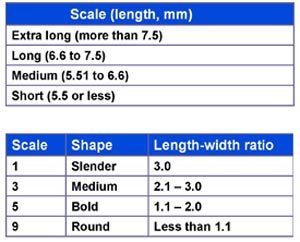Measuring varietal purity
Why do we measure varietal purity?
For seed to be classified as “good or certified,” it must be able to pass a seed certification standard that determines whether the seed is true to varietal type.
How do we measure varietal purity?
The measurements needed to determine varietal purity are grain size and shape, 1000-grain weight, and number of red grains in the sample.
Grain size and shape
Grain size and shape (length-width ratio) is a very stable varietal property that can be used to measure the varietal purity of a sample. Comparing the length-width ratio of the sample with a published ratio for the variety will give an indication of varietal purity of the grain sample. A significant deviation means that the sample is impure – that is, it is either a different variety or a mixture of varieties.
 Obtain a random sample from the seed batch.
Obtain a random sample from the seed batch.- Collect 20 grains at random from this sample of seed.
- Use a Vernier caliper or photographic enlarger to measure the dimensions of each grain.
1000 grain weight
Each variety has a published weight for 1000 grains. If the 1000-grain weight calculated from the sample departs from this, it may be an indication that the sample contains a mixture of varieties.
- Select a random sample from the seed batch
- Count 1,000 whole grains from the sample.
- Weigh the 1,000 grains.
Number of red grains
A grain is considered “red” if more than 25% of its surface area is red-colored or streaked.
- Select a random sample of the milled rice. 25 g is a good sample size.
- Weigh the sample.
- Select and separate the red grains from the sample. The red kernels are those that have 25% or more of the grain colored red.
- Weigh the red grains separated from the sample.
- Calculate the percentage of red grains in the sample.
For more information:
Visit the Rice Knowledge Bank website (http://www.knowledgebank.irri.org), email postharvest@irri.org; or call +63 2 580 5600.







